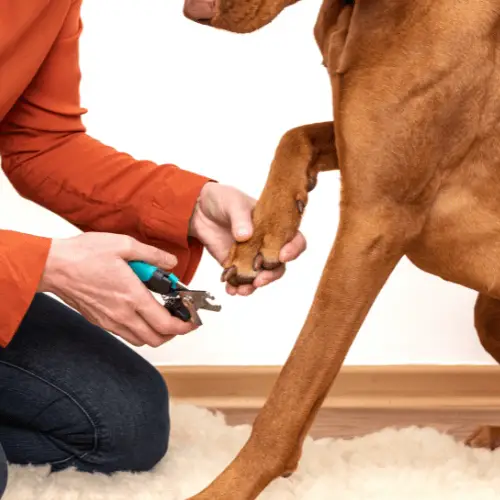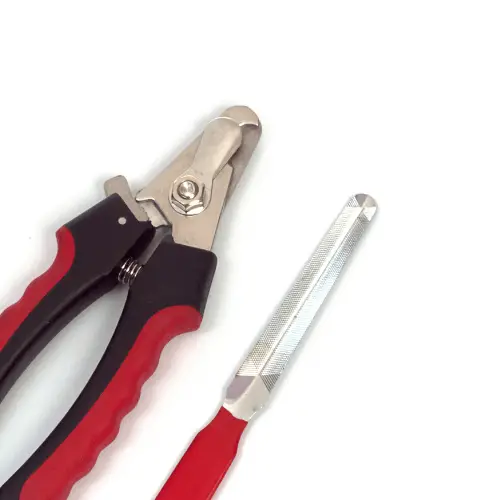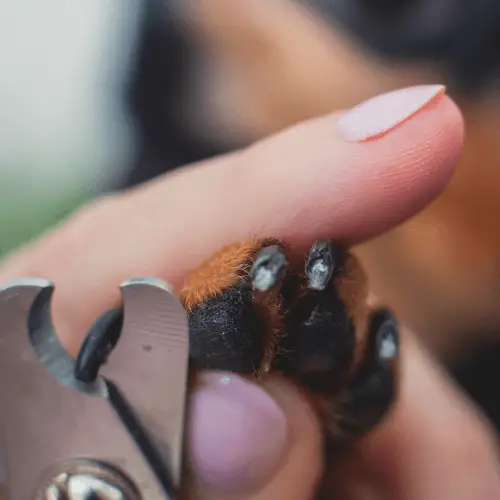
Importance of Regular Nail Trimming for Dogs
Trimming your dog’s nails is a crucial aspect of their grooming routine. Regular nail trimming is essential for maintaining your dog’s overall health and well-being. Some of the key benefits of keeping your dog’s nails trimmed include:
- Preventing broken or ingrown nails
- Avoiding mobility issues and discomfort
- Ensuring proper hygiene
- Reducing the risk of injury to both the dog and its owner
Typically, dogs need their nails trimmed every 3-4 weeks, but the frequency may vary depending on the dog’s breed, size, and activity level.
Challenges Faced by Pet Owners
Many pet owners face challenges when it comes to trimming their dog’s nails. Some common issues include:
- Fear or anxiety in the dog during nail trimming
- Difficulty handling uncooperative or aggressive dogs
- Identifying the quick in dark-colored nails
- Lack of experience or confidence in trimming nails properly
Despite these challenges, it’s essential for pet owners to develop a consistent nail trimming routine to ensure their dog’s health and comfort. In the following sections, we’ll discuss the tools and techniques needed to overcome these challenges and make nail trimming a stress-free experience for both you and your dog.

Tools and Equipment
When it comes to trimming your dog’s nails, having the right tools and equipment is essential. Here’s a list of items you’ll need to make the process easier and more efficient:
Types of Dog Nail Clippers
- Guillotine-style clippers: These clippers have a hole where you insert the dog’s nail, and a blade that slides across to cut the nail when you squeeze the handles. Guillotine clippers are generally best for small- and medium-sized dogs[4].
- Scissor-style clippers: Also known as plier-style clippers, these have two curved blades that cut the nail when the handles are squeezed together. Scissor-style clippers work well for most dogs and are particularly useful for beginners[2].
Nail Grinders and Files
- Nail grinders: These motorized tools gently file down the nail rather than cutting through it. Nail grinders are great for achieving a smooth finish and can be especially helpful for dogs with thick nails or those that are fearful of traditional clippers[4].
- Nail files: Manual nail files can be used to smooth out any jagged edges left after using clippers. While not as efficient as grinders, they can still be useful for touch-ups and maintaining your dog’s nails between trims.
Styptic Powder or Other Clotting Agents
Accidents can happen while trimming your dog’s nails, and it’s important to be prepared in case you accidentally cut the quick. Styptic powder is a clotting agent that can quickly stop bleeding if applied to the affected area. Having some on hand can provide peace of mind and help you address any issues that may arise during the nail trimming process.

Preparing Your Dog
Before you begin trimming your dog’s nails, it’s essential to prepare them for the process. This will help ensure a smooth and stress-free experience for both you and your pet.
Building Trust and Comfort with Nail Trimming
- Start by familiarizing your dog with the tools you’ll be using. Let them sniff and investigate the clippers or grinder.
- Gradually introduce your dog to the sensation of having their paws touched. Gently hold and massage their paws, rewarding them with praise and treats for remaining calm.
- Practice holding your dog’s paw in the same position you’ll use during nail trimming. This will help them become comfortable with the process.
Training Techniques for Puppies and Adult Dogs
- Begin training as early as possible. Puppies are more adaptable and can learn to accept nail trimming more easily than adult dogs.
- Use positive reinforcement, such as treats and praise, to reward your dog for remaining calm during the process.
- Be patient and consistent. It may take several sessions for your dog to become comfortable with nail trimming.
Tips for Handling Uncooperative or Aggressive Dogs
- Create a calm and quiet environment for nail trimming. This can help reduce anxiety and stress for your dog.
- Consider using a muzzle if your dog is prone to biting during nail trimming. This can help protect you and your dog from injury.
- If your dog is particularly uncooperative or aggressive, it may be best to seek the help of a professional groomer or veterinarian for nail trimming. They have the experience and tools necessary to safely handle difficult dogs.
By preparing your dog and using these tips, you can make nail trimming a more enjoyable experience for both you and your pet.
Step-by-Step Guide to Cutting Dog Nails

Follow these steps to properly trim your dog’s nails:
Identifying the Quick in Different Nail Colors
- For dogs with light-colored nails, the quick is visible as a pinkish area inside the nail.
- For dogs with dark-colored nails, the quick is harder to see. Look for a small, dark circle in the center of the nail as you trim. Stop trimming when you see this circle.
Holding Your Dog’s Paw Correctly
- Gently hold your dog’s paw with one hand, placing your thumb on the pad of a toe and your forefinger on the top of the toe, above the nail.
- Make sure not to squeeze too tightly, as this can cause discomfort and make your dog anxious.
Trimming Techniques for Various Dog Breeds and Sizes
- For small- and medium-sized dogs, guillotine-style clippers work well. Insert the nail into the hole and squeeze the handles to cut the nail.
- For larger dogs or beginners, scissor-style clippers are recommended. Place the curved blades around the nail and squeeze the handles to cut.
- Regardless of the clipper type, always cut from top to bottom and perpendicular to the nail.
How Short to Cut Nails and How Often
- Trim only the tip of the nail, avoiding cutting past the curve of the nail or too close to the quick.
- Don’t forget to trim the dewclaws, located on the inner side of the paw.
- Typically, dogs need their nails trimmed every 3-4 weeks, but this may vary depending on breed, size, and activity level.
By following these steps and adjusting your technique based on your dog’s breed and size, you can ensure a safe and effective nail trimming experience.
Dealing with Special Cases
In some situations, trimming your dog’s nails may require extra care and attention. Here are some tips for handling special cases:
Cutting Nails of Dogs with Black Nails
- Trim small amounts at a time to avoid cutting the quick.
- Look for a small, dark circle in the center of the nail as you trim. Stop trimming when you see this circle.
- Use a flashlight to help illuminate the nail and make the quick more visible.
Trimming Nails of Specific Breeds (e.g., German Shepherds)
- Follow the general nail trimming guidelines, but be aware that some breeds may have thicker nails that require more force to cut.
- Pay attention to breed-specific grooming needs, such as double-coated breeds that may require additional care for their paws and nails.
- Consult with a professional groomer or veterinarian if you’re unsure about the best approach for your dog’s breed.
Managing Fearful or Aggressive Dogs During Nail Trimming
- Create a calm and quiet environment for nail trimming to reduce anxiety and stress.
- Use positive reinforcement, such as treats and praise, to reward your dog for remaining calm during the process.
- Consider using a muzzle if your dog is prone to biting during nail trimming.
- If your dog is particularly fearful or aggressive, seek the help of a professional groomer or veterinarian for nail trimming.
By being mindful of these special cases and adjusting your approach accordingly, you can ensure a safe and successful nail trimming experience for your dog.
Aftercare and Maintenance
Once you’ve successfully trimmed your dog’s nails, it’s essential to maintain them and be prepared for any potential issues.
What to Do if You Accidentally Cut the Quick
- Remain calm and reassure your dog.
- Apply styptic powder or another clotting agent to the affected area to stop the bleeding.
- Monitor the nail for any signs of infection or complications.
Monitoring Your Dog’s Nails for Optimal Length
- Check your dog’s nails regularly, at least once every two weeks.
- Listen for clicking sounds when your dog walks on hard surfaces. This can indicate that their nails are too long.
- Keep an eye on the quick’s position, especially if your dog has dark nails. This will help you determine when it’s time for another trim.
Costs and Benefits of Professional Grooming Services
- Professional groomers have the experience and tools necessary to handle difficult or fearful dogs.
- Grooming services can save you time and effort, especially if you’re inexperienced or uncomfortable with nail trimming.
- The cost of professional grooming services varies depending on your location and the specific services provided. Weigh the costs against the benefits to determine if professional grooming is the right choice for you and your dog.
By following these aftercare and maintenance tips, you can ensure your dog’s nails remain healthy and well-groomed. Regular nail trimming is an essential part of your dog’s overall care, so be sure to stay consistent and attentive to their needs.
Conclusion
In this guide, we’ve covered the importance of regular nail trimming for your dog’s health and well-being. By maintaining a consistent grooming routine, you can prevent potential issues such as broken or ingrown nails, mobility problems, and discomfort for your pet.
We’ve discussed the tools and equipment needed for nail trimming, including different types of clippers, nail grinders, and styptic powder. We’ve also provided tips for preparing your dog for nail trimming, building trust and comfort, and handling uncooperative or aggressive dogs.
Additionally, we’ve outlined a step-by-step guide to cutting dog nails, including identifying the quick, holding your dog’s paw correctly, and trimming techniques for various breeds and sizes. We’ve also addressed special cases, such as dogs with black nails, specific breeds like German Shepherds, and managing fearful or aggressive dogs during nail trimming.
By following the advice and techniques provided in this guide, you can develop a consistent grooming routine that ensures your dog’s nails are well-maintained and healthy. Remember, regular nail trimming is an essential part of your dog’s overall care, so be attentive to their needs and make nail trimming a positive experience for both you and your pet.
Frequently Asked Questions
- How often should I trim my dog’s nails?
- Typically, dogs need their nails trimmed every 3-4 weeks, but the frequency may vary depending on the dog’s breed, size, and activity level.
- What tools do I need to cut my dog’s nails?
- You’ll need dog nail clippers (guillotine-style or scissor-style), a nail grinder or file, and styptic powder or another clotting agent.
- How can I tell if my dog’s nails are too long?
- If your dog’s nails make clicking sounds when walking on hard surfaces or if the nails are curling under the paw, they may be too long.
- What is the quick, and how can I avoid cutting it?
- The quick is the blood vessel inside the nail. To avoid cutting it, trim only the tip of the nail and look for a small, dark circle in the center of the nail as you trim.
- How do I get my dog comfortable with nail trimming?
- Familiarize your dog with the tools, gently hold and massage their paws, and practice holding their paw in the trimming position. Use positive reinforcement, such as treats and praise.
- What should I do if I accidentally cut the quick and my dog’s nail starts bleeding?
- Remain calm, reassure your dog, and apply styptic powder or another clotting agent to the affected area to stop the bleeding.
- Can I use human nail clippers on my dog?
- It’s not recommended to use human nail clippers on your dog, as they are not designed for the shape and thickness of dog nails.
- What is the difference between guillotine-style and scissor-style dog nail clippers?
- Guillotine-style clippers have a hole where you insert the nail and a blade that slides across to cut the nail, while scissor-style clippers have two curved blades that cut the nail when squeezed together.
- How do I hold my dog’s paw while trimming their nails?
- Gently hold your dog’s paw with one hand, placing your thumb on the pad of a toe and your forefinger on the top of the toe, above the nail.
- Should I cut my dog’s dewclaw, and if so, how?
- Yes, you should trim the dewclaw, which is located on the inner side of the paw. Use the same trimming technique as for the other nails.
- How can I keep my dog calm during nail trimming?
- Create a calm and quiet environment, use positive reinforcement, and be patient and consistent during the process.
- Are there any alternatives to cutting my dog’s nails, such as filing or grinding?
- Yes, you can use a nail grinder or file to maintain your dog’s nails, which can be especially helpful for dogs with thick nails or those that are fearful of traditional clippers.
- How do I know when to stop trimming my dog’s nails?
- Stop trimming when you see a small, dark circle in the center of the nail or when you’ve reached the curve of the nail.
- Can I trim my dog’s nails myself, or should I take them to a professional groomer?
- You can trim your dog’s nails yourself, but if you’re inexperienced or uncomfortable, it may be best to seek the help of a professional groomer or veterinarian.
- What are the potential health issues if I don’t trim my dog’s nails regularly?
- Neglecting regular nail trimming can lead to broken or ingrown nails, mobility issues, discomfort, and increased risk of injury to both the dog and its owner.
- How can I train my dog to tolerate nail trimming from a young age?
- Start training as early as possible, use positive reinforcement, and be patient and consistent in your approach.
- Are there any specific techniques for trimming the nails of small dogs versus large dogs?
- Guillotine-style clippers are generally best for small- and medium-sized dogs, while scissor-style clippers work well for most dogs and are particularly useful for beginners.
- How do I deal with dark-colored nails where the quick is difficult to see?
- Trim small amounts at a time and look for a small, dark circle in the center of the nail as you trim. You can also use a flashlight to help illuminate the nail and make the quick more visible.
- What should I do if my dog is fearful or aggressive during nail trimming?
- Create a calm and quiet environment, use positive reinforcement, consider using a muzzle, and seek the help of a professional groomer or veterinarian if necessary.
- Can I use treats or positive reinforcement to make nail trimming a more pleasant experience for my dog?
- Yes, using treats and positive reinforcement can help your dog associate nail trimming with positive experiences, making the process more enjoyable for both of you.
Hi, I’m John and I love dogs. Ever since I was a kid, I always wanted to have a furry friend by my side. I grew up with a golden retriever named Max, who taught me a lot about loyalty, friendship, and fun. He was my best buddy for 12 years, and I miss him every day.
